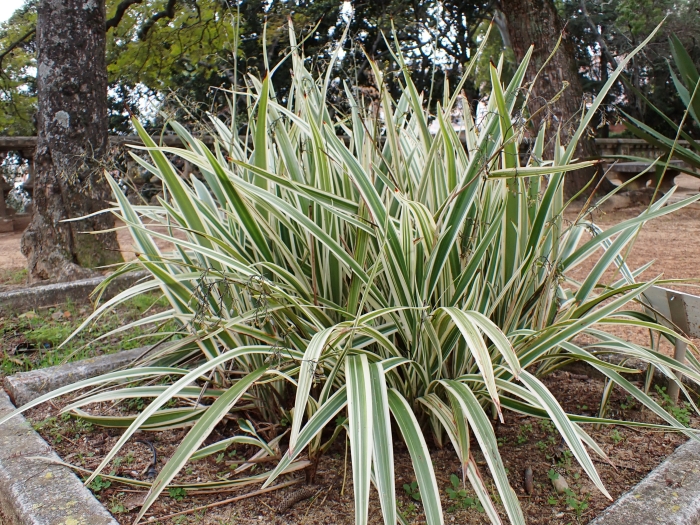Tasman Flax-Lily
(Dianella tasmanica)
Tasman Flax-Lily (Dianella tasmanica)
/
/

Krzysztof Ziarnek, Kenraiz
CC BY-SA 4.0
Image By:
Krzysztof Ziarnek, Kenraiz
Recorded By:
Copyright:
CC BY-SA 4.0
Copyright Notice:
Photo by: Krzysztof Ziarnek, Kenraiz | License Type: CC BY-SA 4.0 | License URL: https://creativecommons.org/licenses/by-sa/4.0 | Uploader: Kenraiz | Publisher: Wikimedia Commons | Title: Dianella_tasmanica_'Variegata'_kz01.jpg | Notes: {{Information |Description=Photograph of the {{MultiLink|Japanese Larch}} ({{BioLinkSpecies|Larix kaempferi}}). Photo taken [[:en:Tyler Arboretum|Tyler Arboretum]] where it was identified.{{Ram-Man Camera 1 | camera = 8700 | focallength =



























































Estimated Native Range
Summary
Dianella tasmanica, commonly known as the Tasman flax-lily or Tasmanian flax-lily, is a perennial herb native to the understory of forests and coastal heaths in southeastern Australia, including Tasmania. It typically grows to a height of 80 cm with strappy, arching leaves and a flower stem that can reach up to 1.5 m. The small, star-shaped blue flowers, about 1.5 cm in diameter, bloom in spring and summer (August to February), creating an attractive display. These are followed by distinctive, roughly oval or globular violet berries, each about 1.2 cm in diameter. However, unlike other Dianella species, the fruit of Dianella tasmanica is toxic and should not be consumed.
The Tasman flax-lily is valued for its hardiness and adaptability to a range of garden settings. It is often used as a border plant, for mass plantings in shaded areas, or as an accent in containers. The variegated cultivar ’Rainbow’ offers additional visual interest with its striped leaves, while ’Little Devil’ is a compact form suitable for smaller spaces, and there is also a salt-tolerant form with red-tinged leaves. This species thrives in part shade but can tolerate a range of light conditions. It prefers well-drained soils and can handle low to medium water availability once established. While it is a low-maintenance plant, it can become invasive outside its native range, so gardeners should be cautious about planting it in areas where it may spread uncontrollably.CC BY-SA 4.0
The Tasman flax-lily is valued for its hardiness and adaptability to a range of garden settings. It is often used as a border plant, for mass plantings in shaded areas, or as an accent in containers. The variegated cultivar ’Rainbow’ offers additional visual interest with its striped leaves, while ’Little Devil’ is a compact form suitable for smaller spaces, and there is also a salt-tolerant form with red-tinged leaves. This species thrives in part shade but can tolerate a range of light conditions. It prefers well-drained soils and can handle low to medium water availability once established. While it is a low-maintenance plant, it can become invasive outside its native range, so gardeners should be cautious about planting it in areas where it may spread uncontrollably.CC BY-SA 4.0
Plant Description
- Plant Type: Herb
- Height: 1.5-2 feet
- Width: 2-3 feet
- Growth Rate: Moderate
- Flower Color: Blue
- Flowering Season: Summer, Fall
- Leaf Retention: Evergreen
Growth Requirements
- Sun: Part Shade
- Water: Low, Medium
- Drainage: Slow, Medium
Common Uses
Bee Garden, Bird Garden, Border Plant, Butterfly Garden, Deer Resistant, Drought Tolerant, Fire Resistant, Groundcover, Hummingbird Garden, Low Maintenance, Potted Plant, Salt Tolerant, Street Planting
Natural Habitat
Understory of forests and coastal heaths in southeastern Australia, including Tasmania
Other Names
Common Names: Tasman Flax-Lily, Blue Berry Flax Lily
Scientific Names: , Dianella tasmanica, Dianella hookeri, Dianella tasmanica var. gigantea, Dianella archeri, Dianella densa, Dianella divaricata f. dentifera, Dianella tasmanica f. laevis, Dianella tasmanica var. variegata,
GBIF Accepted Name: Dianella tasmanica Hook.f.